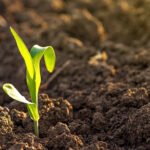Saline soils, a challenging environment for gardeners, are often found in arid, poorly drained, and coastal regions. In arid areas with a high water table, dissolved salts are drawn up from the groundwater through capillary action.
In coastal regions, salt from the ocean accumulates in the soil due to wind-blown particles. Fertilizers and salt used on roads can also contribute to soil salinity in some areas. Saline soils can be detrimental to many plants, but with strategic planning and thoughtful plant selection, gardeners can cultivate beautiful landscapes that defy the odds.
In this article, we explore effective strategies for working with saline soil and creating thriving gardens.
1. Select Plants Adapted to Saline Soils:
The first step to success in gardening with saline soils is choosing plant species that are naturally adapted to these challenging conditions. Salt-tolerant plants have evolved to thrive in high-saline environments, making them more resilient to the adverse effects of salty soils.
In the eastern US, consider planting redbuds (Cercis spp.), summersweet (Clethra alnifolia), common lilac (Syringa vulgaris), and phlox (Phlox spp.). These plants not only tolerate saline soils but also add beauty and diversity to the garden.
2. Use Mulch to Reduce Salt Accumulation:
In arid areas with saline soils, using mulch is a valuable technique to reduce salt accumulation and conserve soil moisture. Mulching helps decrease evaporation at the soil surface, preventing salt from concentrating as water evaporates. However, avoid mulching with materials that are high in salt, such as animal manures or wood ash, as they can exacerbate the problem.
3. Incorporate Low-Salt Organic Materials:
Improving soil drainage in saline soils is essential to manage salt accumulation effectively. Incorporating compost or other organic materials that are low in salt can help enhance soil structure and reduce water retention. This practice dilutes the salt concentration and creates a more favorable environment for plant growth.
4. Conduct Soil Tests for Salinity:
Regular soil tests are essential for understanding and managing soil salinity. Soil tests can determine the level of salt in the soil, providing valuable insights into the appropriate amendments and plant choices.
By monitoring soil salinity, gardeners can adjust their gardening practices accordingly, ensuring a balanced and healthy environment for their plants.
5. Implement Proper Irrigation Practices:
Proper irrigation is critical in saline soils. Overwatering can lead to salt buildup, as excessive water evaporates, leaving behind concentrated salt deposits. Implement efficient irrigation techniques, such as drip irrigation or soaker hoses, to deliver water directly to the plant roots while minimizing surface evaporation.
6. Monitor Plant Health Closely:
Monitor the health of your plants closely in saline soils. Salt stress can manifest as wilting, leaf burn, or stunted growth. Adjust your gardening practices if you observe any signs of salt-related stress, such as reducing the frequency of watering or selecting more salt-tolerant plant varieties.
By embracing these strategies and adapting gardening practices to the unique characteristics of saline soils, gardeners can create vibrant and resilient landscapes. Salt-tolerant plants add character and beauty to the garden, showcasing the wonders of nature’s adaptability. With patience, care, and a touch of ingenuity, saline soils can become a canvas for cultivating stunning and flourishing gardens that triumph over adversity.




Pingback: 9 Essential Steps For Successful Composting - Home Hyme